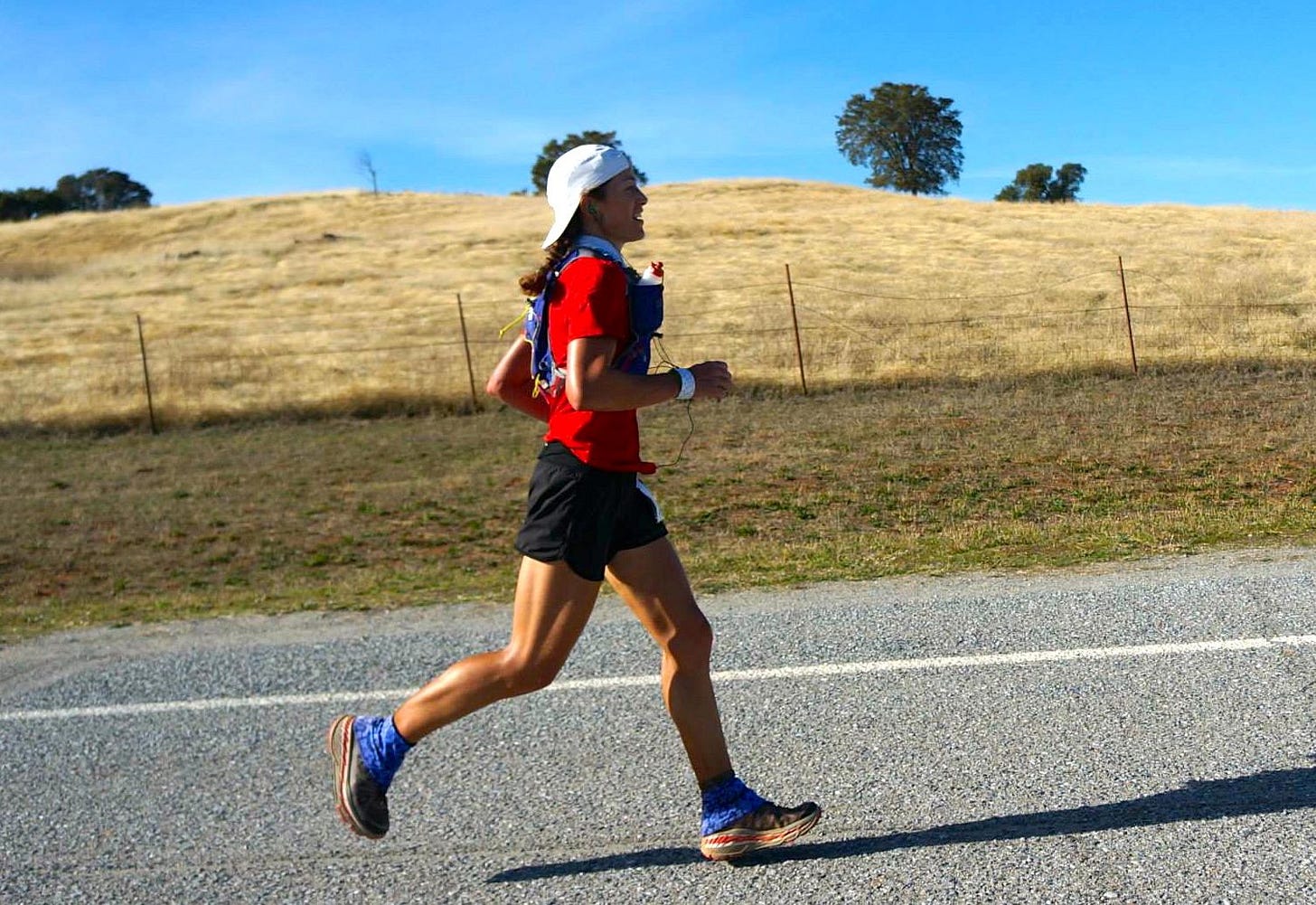I received a lot of messages of encouragement after last week’s “big cry” post, so thank you. This week’s post will be less personal, more practical. Stay tuned for next week when I’ll profile a Colorado mountain runner I greatly admire. Hint: he’s 49 and finally got into Hardrock after years of trying; he frequently podiums with much younger guys; and every time I cross paths with him at a trail race, he strikes me as one of the most positive people in the sport. Any guesses who?
This is the time of year when many of us plan the coming year’s training blocks and goal races. I relish the annual practice, blended with the holidays and winter solstice, of contemplating where to run and what to train for in the new year. It’s escapist in part, like travel research, and gets the mind off worries and work.
Getting a special race on calendar, and booking a hotel for the nights before and after it, also nurtures optimism and the sense that we have at least a smidge of control over future events. Of course, I could get injured, or a wildfire or even a global pandemic could break out and force event cancelation—shit has happened and will continue to blow the best-laid plans—but the act of getting that confirmation email, and outlining the weeks of workouts with progressively higher mileage, satisfies me far more than checking off any house or work project on my to-do list.
I used to set my heart on a marathon PR that also served as a BQ (a Boston Qualifier). Marathons such as Chicago, Napa, Big Sur, California International, and Boston itself shaped my late 20s and 30s, each a memorable pilgrimage and celebration of months of training that I shoehorned into life while raising two little kids. I started this list that I still maintain to keep track of my marathons and ultras.
In 2010 at age 41, after several years of marathons and 50Ks, I crossed over to a more significant ultra distance insofar as it requires a different approach to training, pacing, and self-care mid-race: the 50-miler. Four years later, the 100-miler. Then came mountain 100s that are Hardrock qualifiers—Wasatch, Run Rabbit Run, High Lonesome.

I have not tackled a 200-miler and don’t have plans to do so. For now, the 200-mile multi-day slog-fest that involves near-sleepwalking as much or more than running doesn’t interest me. I’d rather train to run a 100 as best I can. For an extra-long distance, I’m still attracted to self-supported stage races of 150 – 170 miles broken into stages over a week (modeled after the Marathon des Sables format), with each day’s stage feeling like a real race. I ran the Grand to Grand Ultra three times, and its sister race in Hawaii once, and loved this format.
Choosing your “A” race
How do you choose which 100 (or any special ultra) to make your “A” race for the year? I suggest thinking about the following questions:
Does the destination, including its terrain and climate, excite you? Choose a race that takes place where you yearn to spend a few days in and around the host town, immersed in its landscape. Also consider whether you can handle the terrain (e.g. desert sand, mountain rocks, or the likelihood of miles of mud) and the climate. I love visiting Vermont, for example, but I’ve never wanted to do the Vermont 100 because of its notorious humidity in July.
What course profile and format do you prefer? It could be a point-to-point journey (like The Bear or Wasatch), a big loop (like Hardrock), an out-and-back (like Leadville), or repeat loops (like Javelina or the Headlands Hundred). It could be pancake flat (like the Thames Path 100 in England I’ve considered running) or have 40,000 feet of vertical gain and descent (like Ouray).
Is it a qualifier you need? If you care about getting into Western States, Hardrock, or another marquee ultra, then you will need to run one of the ultras listed as a qualifier to enter that event’s lottery.
Will you rely heavily on crew, and if so, is it a crew-friendly race? Some 100s are much more accessible than others.
Does the date work for you? Make sure the race falls at a good time of year for you to peak train and taper in the two months prior and then spend a long weekend at the event. When my kids were school age, I tended to avoid races in late August and early September because the back-to-school season was so busy and kid-focused.
Does the race organization and its race director have a good reputation? I gravitate toward Aravaipa Running and Mad Moose events, and also ran a lot of NorCal Ultra events when I lived in California, because I feel a certain level of trust and confidence in their race directors. By contrast, I shared the trail with a certain RD when we ran Speedgoat 50K together several years ago, and when I heard him talking on the trail like a boastful a-hole and saw how he flamed people on social media, I concluded I would never run any of his high-profile races. A couple of years later, he was exposed as the unethical jerk I suspected he was.
Is it a “redemption race” (i.e. a do-over or do-better attempt)? Running the same event more than once for the challenge of improving on the course is a powerful motivator, and what’s more, knowing the route and its logistics makes for more confidence going at it a second time. Beware, however, of signing up for it again if you had a bad experience the first time and your heart isn’t fully into it.
I took those questions into consideration when I chose my main 100 for 2023 (which is a backup to Hardrock, since I didn’t get into Hardrock). I’m signed up for Run Rabbit Run 100 in Steamboat Springs in mid-September, and I’m stoked about it!
I ran Run Rabbit Run in 2017, when the course was slightly easier, and had a disappointing performance (in part because the sky was full of wildfire smoke). I’m eager to go back and tackle the newer version of the course, hopefully in better weather and clear air. I like that it’s a giant loop with the start/finish in a resort town where my husband, joined by our kids if they can make it, will enjoy hanging out in between crewing me. I’m also excited to have a big race in September, meaning I can spend all summer building up to it a bit more gradually (unlike the past two summers when I got ready for High Lonesome 100 by July).
Here’s a photo from the 2017 edition of Courtney Dauwalter, the year she really started to dominate ultras. One of my fond memories from the race is hanging out with her afterwards, discovering what a down-to-earth friendly soul she is, and hearing her describe how her corneas froze and she was practically blind running the last 10 miles of the race in the dark. She tripped and bashed her head in, yet she still finished for the win. (She tells the story in this podcast interview I co-hosted.)
Colorado 100-milers in chronological order
Want to run a 100 in this great state? Sure you do, or at least you’re curious, so here are your choices. Prepare for high altitude and extreme mountain weather. (If I missed any 100M race in CO, please mention it in the comments.) Those marked with a * are those I’ve experienced personally as a runner or pacer/crew/volunteer and can recommend. The others I don’t know much about beyond word-of-mouth and what their websites say.
Great Divide 100, June 3. Mueller State Park west of Colorado Springs.
Mace’s Hideout 100, June 3. It’s one of three relatively new 100s in the state by Tempest Adventures, a homegrown race company started by Chris and Marci Westerman. Mace’s Hideout takes place in the Wet Mountains, a subrange of the Sangre de Cristo Mountains near Pueblo.
Ring the Springs, June 17. A 100-miler around Colorado Springs started in 2022 by Aravaipa Running.
Silverheels 100, July 8. This takes place in the mountains north of Fairplay and is one of several ultras by Human Potential Running and RD “Sherpa” John Lacroix.
* Hardrock 100, July 14. I’ve been trying since 2015 to get in. If you want to know more, search this newsletter’s archives for several posts about this iconic race that loops around the San Juan Mountains.
* High Lonesome 100, July 21. Lottery opens January 2. Those of you who follow this newsletter know that I love this race (2022 report here). It’s a Hardrock qualifier.
* Ouray 100, July 21. Crazy tough, arguably tougher than Hardrock with more vert. See my DNF report from 2018.
Silverton Ultra Dirty 100, August 4. This event by Megan Finnesy’s Dirty 30 race organization runs from Durango to Silverton along the Colorado Trail.
High Five 100, August 11. This race makes Hardrock look as mild as Javelina Jundred. Self-navigated, minimal support, five 14’ers … it’s for the truly hard-core and experienced mountain athletes.
Leadville 100, August 19. So many people love this classic Colorado 100 that’s a big out-and-back, but I’ve never felt drawn to it because it seems overly crowded and overhyped.
Divide 100, August 25. Starts and finishes in the historic town of Georgetown west of Denver.
Creede 100, August 26. A race started in 2022 by the same people behind Mace’s Hideout. A friend ran it last August and said its setting is gorgeous, much of it above 12,000 feet on the Continental Divide Trail.
* Run Rabbit Run 100, September 15. The “tortoise” (non-elite) division is close to full, so register soon if you want to run it. It’s a Hardrock qualifier. See you there?!
Rio Grande 100, September 30. Along with Creede and Mace’s Hideout, it’s a relatively new event and part of a triple crown series by Tempest Adventures. It takes place in South Fork (southeast of Creede) in the La Garita Mountains.
Sangre de Cristo 100 (with a 150-mile option!), September 23. In the Sangre de Cristo range in southeast Colorado. Put on by same RD as Silverheels.
Have you registered for a big race in 2023? What went into choosing it? Comment below and/or join the chat thread.






Ha! I'm just proud of myself for deciding to train for a half marathon for 2023! Forget 100 miles!
Great post. I did not get in to WS so I’ll be looking for 128 🤪 tickets somewhere. I’d love to do a mtn race but as a flat lander the altitude scares me. 100 in altitude as a qualifier just seems too risky at my age! (Not health wise just DNF wise!) Thought about Never Summer 100K but it doesn’t fit into my schedule so I’ll keep looking, I might just do Kettle 100 in WI since I had my head wrapped around a June 100 anyway and it gives me the fall for a backup qualifier if something goes wrong. I too love the annual planning! Thanks for giving me some food for thought!